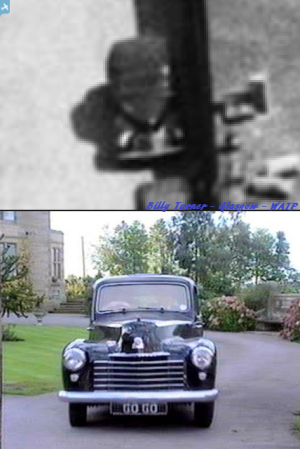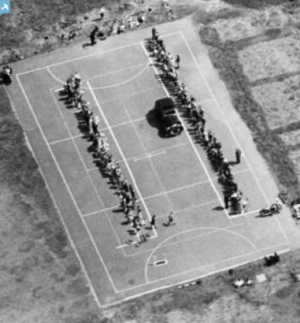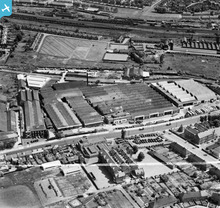EAW043289 ENGLAND (1952). The Duple Coachbuilding Works on Edgware Road, The Hyde, 1952. This image was marked by Aerofilms Ltd for photo editing.
© Copyright OpenStreetMap contributors and licensed by the OpenStreetMap Foundation. 2025. Cartography is licensed as CC BY-SA.
Nearby Images (15)
Details
| Title | [EAW043289] The Duple Coachbuilding Works on Edgware Road, The Hyde, 1952. This image was marked by Aerofilms Ltd for photo editing. |
| Reference | EAW043289 |
| Date | 23-May-1952 |
| Link | |
| Place name | THE HYDE |
| Parish | |
| District | |
| Country | ENGLAND |
| Easting / Northing | 521693, 188569 |
| Longitude / Latitude | -0.24342220574106, 51.582350197997 |
| National Grid Reference | TQ217886 |
Pins
 The Laird |
Friday 13th of January 2023 11:22:28 PM | |
 Luckylea |
Monday 9th of January 2017 11:25:02 PM | |
 Luckylea |
Monday 9th of January 2017 11:15:50 PM | |
 Luckylea |
Monday 9th of January 2017 11:12:32 PM | |
 Luckylea |
Monday 9th of January 2017 11:11:48 PM | |
 Billy Turner |
Monday 9th of May 2016 09:05:51 PM | |
 Billy Turner |
Monday 9th of May 2016 08:43:55 PM | |
 Billy Turner |
Monday 9th of May 2016 08:27:06 PM | |
I'd go further. I'd say that a road safety display team from the local Met Police traffic garage were paying the school a visit on this day. There is also a motor cycle parked up at the bottom left and a couple of other vehicles nearby. I remember the same thing taking place at my primary school, which was not so many miles away from here. |
 The Laird |
Thursday 19th of April 2018 08:02:05 PM |
 Billy Turner |
Monday 9th of May 2016 08:12:13 PM | |
 Billy Turner |
Saturday 7th of May 2016 09:30:31 PM | |
 Billy Turner |
Saturday 7th of May 2016 09:08:19 PM | |
 Billy Turner |
Saturday 7th of May 2016 08:49:34 PM | |
 colsouth111 |
Saturday 23rd of August 2014 10:34:18 AM | |
 colsouth111 |
Saturday 23rd of August 2014 10:33:35 AM | |
 colsouth111 |
Saturday 23rd of August 2014 10:21:55 AM | |
 colsouth111 |
Saturday 23rd of August 2014 10:21:15 AM | |
My Dad was a postman and driver here during the 1950's and 60's until he retired in the mid 1970's. They always organised a Christmas Party for the staff's kids, my younger sister and I went to a few. The GPO was a good solid employer then, sadly not anymore. The Post Office Fellowship had hotels and holiday sites all around the country run for the benefit of the members. One in Westgate-on-Sea, Ledge Point appears on this web site, great place for a couple of weeks for a child brought up in a working class North London council home. Something I have never forgotten. |
 NthLondonBoy |
Sunday 5th of October 2014 08:09:28 PM |
 colsouth111 |
Saturday 23rd of August 2014 10:20:25 AM | |
 colsouth111 |
Saturday 23rd of August 2014 08:44:20 AM |
User Comment Contributions
My Uncle Jim Green was a coach builder here for quite a few years. We always made sure the coach we went on to the seaside in was a Duple built coach. They don't build them like them anymore, full of character and no air-con? |
 NthLondonBoy |
Sunday 5th of October 2014 08:12:34 PM |
 colsouth111 |
Saturday 23rd of August 2014 10:40:41 AM |


![[EAW043289] The Duple Coachbuilding Works on Edgware Road, The Hyde, 1952. This image was marked by Aerofilms Ltd for photo editing.](http://britainfromabove.org.uk/sites/all/libraries/aerofilms-images/public/100x100/EAW/043/EAW043289.jpg)
![[EAW043287] The Duple Coachbuilding Works on Edgware Road, The Hyde, 1952. This image was marked by Aerofilms Ltd for photo editing.](http://britainfromabove.org.uk/sites/all/libraries/aerofilms-images/public/100x100/EAW/043/EAW043287.jpg)
![[EAW043286] The Duple Coachbuilding Works on Edgware Road, The Hyde, 1952. This image was marked by Aerofilms Ltd for photo editing.](http://britainfromabove.org.uk/sites/all/libraries/aerofilms-images/public/100x100/EAW/043/EAW043286.jpg)
![[EAW043288] The Duple Coachbuilding Works on Edgware Road, The Hyde, 1952. This image was marked by Aerofilms Ltd for photo editing.](http://britainfromabove.org.uk/sites/all/libraries/aerofilms-images/public/100x100/EAW/043/EAW043288.jpg)
![[EAW043282] The Duple Coachbuilding Works on Edgware Road, The Hyde, 1952. This image was marked by Aerofilms Ltd for photo editing.](http://britainfromabove.org.uk/sites/all/libraries/aerofilms-images/public/100x100/EAW/043/EAW043282.jpg)
![[EAW043283] The Duple Coachbuilding Works on Edgware Road, The Hyde, 1952. This image was marked by Aerofilms Ltd for photo editing.](http://britainfromabove.org.uk/sites/all/libraries/aerofilms-images/public/100x100/EAW/043/EAW043283.jpg)
![[EAW043284] The Duple Coachbuilding Works on Edgware Road, The Hyde, 1952. This image was marked by Aerofilms Ltd for photo editing.](http://britainfromabove.org.uk/sites/all/libraries/aerofilms-images/public/100x100/EAW/043/EAW043284.jpg)
![[EAW043285] The Duple Coachbuilding Works on Edgware Road, The Hyde, 1952. This image was marked by Aerofilms Ltd for photo editing.](http://britainfromabove.org.uk/sites/all/libraries/aerofilms-images/public/100x100/EAW/043/EAW043285.jpg)
![[EAW020702] The Edgware Road running through Edgware and Stanmore, Hendon, from the south-east, 1948](http://britainfromabove.org.uk/sites/all/libraries/aerofilms-images/public/100x100/EAW/020/EAW020702.jpg)
![[EAW020703] RAF Hendon and environs, Hendon, from the south, 1948](http://britainfromabove.org.uk/sites/all/libraries/aerofilms-images/public/100x100/EAW/020/EAW020703.jpg)
![[EAW020697] The Hyde and environs, Hendon, 1948](http://britainfromabove.org.uk/sites/all/libraries/aerofilms-images/public/100x100/EAW/020/EAW020697.jpg)
![[EAW020701] The Edgware Road running through Edgware and Stanmore, Hendon, from the south-east, 1948](http://britainfromabove.org.uk/sites/all/libraries/aerofilms-images/public/100x100/EAW/020/EAW020701.jpg)
![[EPW032167] Spurlings Motor Body Works, The Hyde, 1930](http://britainfromabove.org.uk/sites/all/libraries/aerofilms-images/public/100x100/EPW/032/EPW032167.jpg)
![[EPW021259] New housing under construction at Goldsmith Avenue, The Hyde, 1928](http://britainfromabove.org.uk/sites/all/libraries/aerofilms-images/public/100x100/EPW/021/EPW021259.jpg)
![[EPW005719] The Schweppes Mineral Water Factory, West Hendon, 1921. This image has been produced from a copy-negative.](http://britainfromabove.org.uk/sites/all/libraries/aerofilms-images/public/100x100/EPW/005/EPW005719.jpg)







